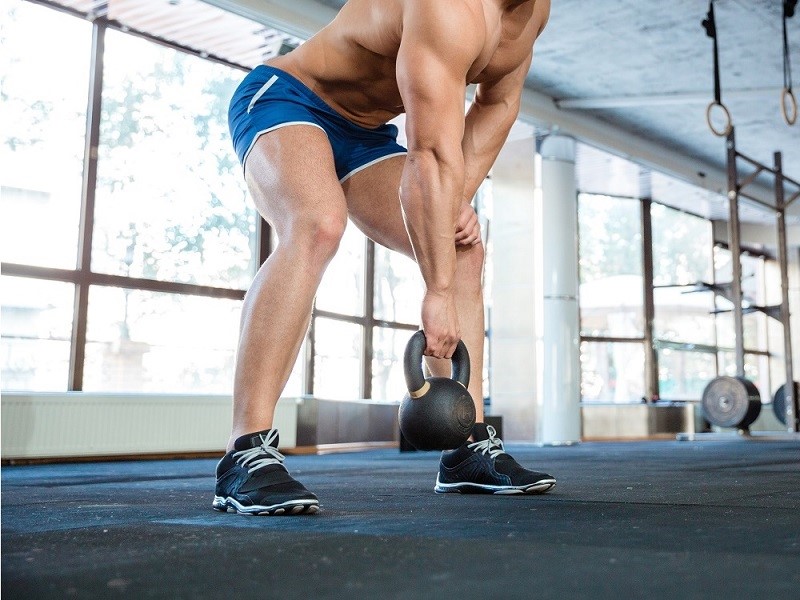What is HIIT and its benefits?

High intensity interval training or HIIT is a form of cardio exercise done in short, intense bursts that aims to maximise athletic performance under conditions where the muscles are deprived of oxygen.
HIIT is a great form of exercise to include in your workout routine if you are seeking to build strength and muscle endurance or trying to lose weight.
 Photo: Active Health
Photo: Active Health
Why HIIT is so good for you?
� HIIT is an effective way to burn fat
You might already know that cardio exercises are effective for fat mobilisation. As a pumped up and intense form of cardio, HIIT is the best exercise to engage in when your goal is to burn away stubborn fat. The intensity of the exercise leads to an increased rate of fat oxidation as well as excess post-exercise oxygen consumption, which occurs when your body recovers from its oxygen-deprived state during the HIIT exercise. During this stage, adipose tissues are broken down and converted into fuel.
� HIIT regulates your appetite
If you�re prone to overeating, HIIT will do you some good in managing your appetite. The intensity of HIIT causes a decrease in the amount of ghrelin � an appetite-regulating hormone � which reduces your appetite. At the same time, HIIT also increases your blood sugar and blood lactate level temporarily, which also brings your appetite down.
� HIIT increases the amount of oxygen your body can absorb in a minute
This rate is known as VO2max � a word that gets thrown around a lot when it comes to HIIT. VO2max is important because it affects the physical capacity of your athletic performance. With a higher VO2max, your body has better endurance in aerobic exercises. Besides improving athletic conditioning, an increased VO2max also brings us better overall health.
VO2max is strongly associated with the health of our telomeres, which are components of our DNA system that regulate the ageing of our cells. Healthy telomeres mean more youthful cells and a reduced risk of cancer.
� HIIT regulates blood glucose levels
People suffering from pre-diabetes or type-2 diabetes can benefit significantly from HIIT because the sport actually increases glucose metabolism and insulin sensitivity, thus helping to regulate blood glucose at healthy levels.
� HIIT is a more efficient form of cardio exercise
HIIT makes it easier to hit the desired number of cardio hours that you need to clock because it�s far more time-efficient. In fact, every hour of HIIT is roughly equivalent to 4 hours of conventional endurance training!
Anyone who does sports can benefit from HIIT. Performance-wise, it makes you fitter, stronger and also improves your general health outside of sports. However, implementing HIIT into your routine isn�t as simple as revving up the number of reps you need to do and reducing the time to complete the sets. There are a number of ways to break down the intervals in HIIT and also methods to ensure you are doing it right.
 Photo: Active Health
Photo: Active Health
Getting started on HIIT
First of all, it�s important to note that HIIT is all about performing at your maximum ability for a short burst of time and then taking a short break. There are a number of ways to structure your exercise to rest ratio. Some people prefer 1:1 exercise to rest ratio, but a 1:2 or 1:3 ratio work perfectly fine too. The rest time depends on your current fitness level, so if you don�t exercise regularly, a longer rest time would be more ideal. There are also many different ways to structure your workout, but here are some of the common ones.
� Circuit
Circuits are great if you want to train various muscles as you will be rotating between different stations in a circuit workout. In circuit, you will spend half to one minute at each station before moving to the next station. The time taken to recover, move and adjust to the new station is the rest timing.
� Pyramid
Pyramid is structured similarly to circuit, but the difference lies in the number of repetitions you do at each station. With circuits for example, the number of repetitions is constant but for pyramids you can choose to either step up or step down the number of repetitions.
� As many rounds as possible
This type of workout is simple but can be very gruelling � all you need to do is set a timer and then keep going until the time is up. There are no �goals� to hit and you only have to strive to do as much as you can.
� Every minute on the minute (EMOM)
In this one, your workout is broken into one-minute intervals. In each interval, you have to complete a designated number of reps of certain exercises. The remaining time before the minute is up is your rest time. Once the minute is over, you restart on a new minute and work to complete your reps all over again.
Feeling breathless from just reading about the intensity? You might be glad to know that HIIT doesn�t have to be done every day. All you need is two or three solid sessions every week and you�re good to go. Rest days are a must � minimally, you should have a 24-hour gap between HIIT sessions to allow your body time to recover. Skipping the rest day can lead to overuse injuries and mental/physical burnout, which could lead to you giving up on exercise for a while so remember to prioritise your rest days.
? JOIN US: Island-wide experiential Move Better workshops led by Active Health Coaches
Other types of cardiovascular training
While HIIT may be one of the most popular fitness conditioning protocols out there today, that is not to say that it is indeed the �best�. The �best� kind of training is the one that's most suited for helping you achieve your training goals. There are different cardiovascular training modalities out there, all of which confer specific benefits:
� Low intensity, long duration
Also known as low-intensity steady state (LISS) training, cardiovascular training that follows such an approach is perfect for obese or elderly individuals, as it provides them with an easy way to increase daily caloric expenditure without risking bone and joint health. It is also a great way to recondition the body for those who are coming out of recovery. This form of training is performed with a maximum heart rate of between 40 - 60%.
� Medium intensity, medium duration
Performing aerobic work at around 70% of one's maximum heart rate categorises is as medium intensity, with the duration of work lasting between 20 and 40 minutes. It is often used for promoting fat loss and increasing work capacity.
� Aerobic interval training
You're probably familiar with this form of training if you're attending at least one aerobics class at some point in your life. It differs slightly from HIIT in that the rest periods are conducted with low-intensity work such as walking instead of full rest. The actual duration of the work/rest period is also typically longer, lasting several minutes in some cases whereas �pure� HIIT is typically counted in seconds. The constant activity and variation make it a good choice for those who are easily bored.
� Fartlek training
Fartlek (which is Swedish for �speed play�) is best described as a melting pot of all the aforementioned forms of cardiovascular training (including HIIT) and is most commonly used with runners for improving speed and endurance. However, it can also be employed in a conventional gym setting. Fartlek aims to train both aerobic and anaerobic capacities, so you can consider mixing heavy tyre flips with rowing for distance, followed by overhead presses and farmers walks. Feel free to practice loads of variation between your exercise choices to keep things fresh!
 Photo: Active Health
Photo: Active Health
Doing HIIT the right way
Speaking of injuries, the physically intensive nature of HIIT makes it a form of training that comes with an inherent risk of injury. This is why it�s important to make sure you are doing HIIT the right way � here are some ways you can nail your HIIT workout while staying injury-free.
� Keep track of your heart rate
Overworking yourself is a problem when it comes to HIIT and measuring your heart rate is a good way to ensure you aren�t aggravating your body excessively. A heart rate monitor (or a fitness wearable that carries such a feature) is a worthy investment when it comes to HIIT as it helps you find out the percentage of your maximum heart rate that your heart is working at.
With HIIT, aim for 75-90bpm (beats per minute) and be careful when you find yourself hitting the upper limit. The exact heart rate targets you should aim to work towards varies from individuals and you should do an individual assessment to get your ideal rates. You can conveniently find out more about your target heart rate and other health variables from our Active Health Coaches at Active Health Labs located island-wide.
� Warm-up
Warm-ups are necessary for any exercise but all the more crucial for HIIT because of its intensive nature. A good HIIT warm-up involves beginning with some low-intensity aerobic exercise like a slow jog, followed by some dynamic stretches to get your muscles ready.
� Watch your form
HIIT is all about pressing on even when your body is giving way � this can come at the expense of your form if you're not careful. Continuing with your repetitions in poor form can cause injuries so it�s extremely important to watch your form when you are doing HIIT. If a prescribed exercise turns out to be too complex for you to perform well consistently, swap it out or reduce the number of repetitions.
� Hydrate and fuel up
Like all physical activities, it�s important to make sure you�re well-hydrated before a HIIT session. When it comes to food, HIIT is one exercise you should never attempt on an empty stomach. The intensity of HIIT means you need lots of stored energy in your body � it may be a good idea to ingest a carbohydrate-rich meal a few hours before working out. Wholemeal toast and bananas are good HIIT workout foods to reach for.
� Have a solid recovery plan
We earlier mentioned the importance of rest days. There are two ways you can go about �doing� a rest day � active recovery where you engage in low-intensity exercises like swimming and cycling or passive recovery where you simply just relax. A good recovery plan involves both active and passive recovery. Active recovery sessions can be broken into groups to help the different muscles recover efficiently before the next HIIT workout.
Doing HIIT the right way will ensure that you stay safe and injury-free and help you reap the maximum fitness and health benefits out of your routines. Training at a high intensity may sound daunting, tiring and even risky but the wonders it does for your level of fitness is well worth the sweat!





![ActiveSG Academies and Clubs Logo (Solid Colour)[8647]](https://www.activesgcircle.gov.sg/hs-fs/hubfs/ActiveSG%20Circle%202023Theme/images/ActiveSG%20Academies%20and%20Clubs%20Logo%20(Solid%20Colour)%5B8647%5D.png?width=150&height=65&name=ActiveSG%20Academies%20and%20Clubs%20Logo%20(Solid%20Colour)%5B8647%5D.png)




-01.png?width=200&height=141&name=Team%20Singapore%20Logo%20(Red)-01.png)






.webp?width=120&height=120&name=Seniors%20Sports%20Day%2c%20Photo%20Credit%20-%20Sport%20Singapore%20(5).webp)



.jpg?width=162&height=162&name=Skechers%20Friendship%20Walk%202025-31Aug2025_thumbnail%20(1).jpg)